|
|
|
Sort Order |
|
|
|
Items / Page
|
|
|
|
|
|
|
| Srl | Item |
| 1 |
ID:
080811
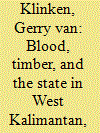

|
|
|
|
|
| Publication |
2008.
|
| Summary/Abstract |
West Kalimantan (West Borneo) has a history of violent communal conflict.1 It also has extensive forests that have been looted for decades. The argument will be that these two are linked, but not by the grievances of the forest dwellers. Except in its first few days, the two main episodes of 1997 and 1999 were not driven mainly by grievances among marginal groups. Rather, explanations based on the 'resource curse' carry more weight. These focus attention on the contested nature of the state, rather than on rebellious activities of marginal groups. When state institutions were thrown into disarray by the sudden resignation of President Suharto in 1998, Dayak militants already close to state power rewrote the rules of local politics by demonstratively 'cleansing' certain areas of an unpopular immigrant minority. This theatrical manoeuvre impressed political rivals sufficiently to allow Dayaks to gain control over several timber-rich districts, which had a thriving black economy. Malays later imitated these techniques to stem the tide
|
|
|
|
|
|
|
|
|
|
|
|
|
|
|
|
| 2 |
ID:
164555
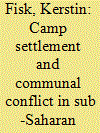

|
|
|
|
|
| Summary/Abstract |
Are areas that host encamped refugees more likely to experience communal conflict, and under what conditions? Building on insights from the refugee studies literature suggesting that settling refugees in camps can intensify intercommunal tension in host communities, this article investigates the effect of refugee encampment on the occurrence of communal conflict at the subnational level in sub-Saharan Africa. It first tests for a general relationship between the overall presence and population intensity of encamped refugees and communal conflict before assessing whether this relationship is moderated by local-level characteristics, including interethnic linkages and political and economic marginalization within the host region. The basic findings show that communal conflict occurs more frequently in regions where refugees are camp-settled. Tests for interactive effects indicate that refugee camps have a significant marginal effect on conflict only if they are located in areas with politically marginalized host groups. Origin country/host region ethnic ties are shown to exert significant moderating effects. Moreover, results from an extended set of analyses show that the form of refugee settlement matters, as the presence and population intensity of self-settled refugees are related to decreases in the occurrence of communal conflict.
|
|
|
|
|
|
|
|
|
|
|
|
|
|
|
|
| 3 |
ID:
164163


|
|
|
|
|
| Summary/Abstract |
Do different types of inequality spur violence with different targets? This article explores whom violent movements choose to target when they take to arms, by comparing civil conflicts, which target the state, to communal conflicts, which target other ethnic groups. Different types of ethnic group disadvantage relate to conflict through different mechanisms. Political exclusion is expected to promote the choice to target the central government rather than other ethnic groups, while economic disadvantages should increase the risk of both civil and communal conflicts. The different expectations stem from two important differences between political and economic horizontal inequalities: only the government has the authority to change the political distribution, while there can be many avenues to economic redistribution; and blame is more straightforwardly assigned to the government for political than for economic disadvantages. Statistical analysis of 155 politically relevant ethnic groups in Africa (1991–2009) provides support for both propositions.
|
|
|
|
|
|
|
|
|
|
|
|
|
|
|
|
| 4 |
ID:
191853
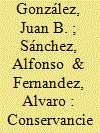

|
|
|
|
|
| Summary/Abstract |
Are conservancies hotspots for communal violence and if so, do rainfall anomalies increase the likelihood of violence? The consensus from a rich number of case studies suggests that conservancies (e.g. national parks, game reserves) increase tensions between communities, which often lead to violent conflicts. Yet, these insights remain to be empirically tested using a large-N study. We examine this claim and explore if rainfall anomalies have an amplifying effect on violent conflicts. We contend that the spatial convergence between conservancies and rainfall variability can spark conflicts over access to resources in times of scarcity and create strategic opportunities to satisfy secondary goals in times of abundance. To test our expectations, we use sub-national data from East Africa between 1990 and 2018. Our results suggest that regions with conservancies are somewhat more prone to communal violence and find strong evidence that positive rainfall anomalies increase the likelihood of violent communal conflicts in regions with a conservancy.
|
|
|
|
|
|
|
|
|
|
|
|
|
|
|
|
| 5 |
ID:
084035
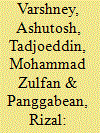

|
|
|
|
|
| Publication |
2008.
|
| Summary/Abstract |
Indonesia has witnessed explosive group violence in recent years, but unlike its plentiful economic statistics, the data on conflict are remarkably sketchy. Because the New Order (1966-1998) wanted to give the appearance of order and stability, it did not believe in publishing reports on group conflict, nor did it allow researchers and nongovernmental organizations to probe the patterns and causes of conflict. This article is based on the first multiyear dataset ever constructed on group violence in Indonesia. Following, and adapting for Indonesian conditions, methodologies developed and used elsewhere, we cover the years 1990-2003, split the data into various categories, and identify the national, regional, and local patterns of collective violence. Much that we find is surprising, given the existing theories and common perceptions about violence in Indonesia. Of the several conclusions we draw, the most important one is that group violence in Indonesia is highly locally concentrated. Fifteen districts and cities (kabupaten and kota), in which a mere 6.5 percent of the country's population lived in 2000, account for as much as 85.5 percent of all deaths in group violence. Large-scale group violence is not as widespread as is normally believed. If we can figure out why so many districts remained reasonably quiet, even as the violent systemic shifts-such as the decline of the New Order-deeply shook fifteen districts causing a large number of deaths, it will advance our understanding of the causes of collective violence in Indonesia.
|
|
|
|
|
|
|
|
|
|
|
|
|
|
|
|
| 6 |
ID:
108676
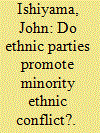

|
|
|
|
|
| Publication |
2009.
|
| Summary/Abstract |
Do ethnic parties exacerbate ethnic conflict? Many scholars have argued that the mere appearance of ethnic parties inevitably leads to a spiral of ethnic conflict and the collapse of incipient democracies. This article tests this proposition by examining how ethnic parties affect protest and communal conflict across 82 countries and 213 ethnic/communal groups from 1985-2003. Using a variety of quantitative techniques, I find that ethnic parties do mobilize minority ethnic groups to engage in protest, but there is no natural connection between the appearance of ethnic parties and the extent to which the minority group engages in communal conflict.
|
|
|
|
|
|
|
|
|
|
|
|
|
|
|
|
| 7 |
ID:
084039


|
|
|
|
|
| Publication |
2008.
|
| Summary/Abstract |
Recent scholarship on communal violence in Indonesia since the late New Order has focused on identifying causal mechanisms of particular subtypes of communal violence such as large-scale communal violence, town-level communal rioting, intervillage violence, and lynching. While such analyses are useful in understanding aspects specific to each subtype of violence, analyzing each subtype separately risks the analytical problem of selection on the dependent variable if there are important similarities across subtypes. Drawing on the observation that each of these subtypes appeared to rise and fall together since the late New Order, I propose a common factor that can explain the broad temporal patterns of communal violence. In particular, I point to increasing restraints on the military that arose from intraregime infighting, greater scrutiny of military actions during the keterbukaan (political openness) period, and the withdrawal of the military from police duties during Reformasi. I examine four cases of communal conflict: (1) a case in which intravillage violence was averted, (2) a case of lynching, (3) a case of lynching and subsequent intervillage reprisals, and (4) a case of large-scale communal violence. The first three cases are from Lampung province, and the fourth is the case of Poso district, Central Sulawesi.
|
|
|
|
|
|
|
|
|
|
|
|
|
|
|
|
| 8 |
ID:
004438
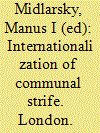

|
|
|
|
|
| Publication |
London, Routledge, 1993.
|
| Description |
xviii,306p.
|
| Standard Number |
0415084083
|
|
|
|
|
|
|
|
|
|
|
|
Copies: C:1/I:0,R:0,Q:0
Circulation
| Accession# | Call# | Current Location | Status | Policy | Location |
| 035018 | 302.14/MID 035018 | Main | On Shelf | General | |
|
|
|
|
| 9 |
ID:
112781
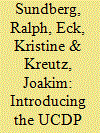

|
|
|
|
|
| Publication |
2012.
|
| Summary/Abstract |
This article extends the Uppsala Conflict Data Program (UCDP) by presenting new global data on non-state conflict, or armed conflict between two groups, neither of which is the state. The dataset includes conflicts between rebel groups and other organized militias, and thus serves as a complement to existing datasets on armed conflict which have either ignored this kind of violence or aggregated it into civil war. The dataset also includes cases of fighting between supporters of different political parties as well as cases of communal conflict, that is, conflict between two social groups, usually identified along ethnic or religious lines. This thus extends UCDP's conflict data collection to facilitate the study of topics like rebel fractionalization, paramilitary involvement in conflict violence, and communal or ethnic conflict. In the article, we present a background to the data collection and provide descriptive statistics for the period 1989-2008 and then illustrate how the data can be used with the case of Somalia. These data move beyond state-centric conceptions of collective violence to facilitate research into the causes and consequences of group violence which occurs without state participation.
|
|
|
|
|
|
|
|
|
|
|
|
|
|
|
|
| 10 |
ID:
133701


|
|
|
|
|
| Publication |
2014.
|
| Summary/Abstract |
Common notions about the source of communal land conflict in Africa have long explained it as growing out of conditions of environmental scarcity. This article argues instead that the institutional structure of the legal system is central to understanding which countries are prone to experience communal land conflict. When competing customary and modern jurisdictions coexist in countries inhabited by mixed identity groups, the conflicting sources of legal authority lead to insecurity about which source of law will prevail. Because the source of law is contested, conflict parties cannot trust the legal system to predictably adjudicate disputes, which encourages the use of extrajudicial vigilante measures. Using new data on communal violence in West Africa, this argument is examined for the period 1990-2009. The results show that in countries where competing jurisdictions exist, communal land conflict is 200-350% more likely. These findings suggest that researchers should consider the role of legal institutions and processes in relation to social unrest and collective violence
|
|
|
|
|
|
|
|
|
|
|
|
|
|
|
|
| 11 |
ID:
074890
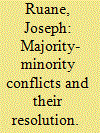

|
|
|
|
|
| Publication |
2006.
|
| Summary/Abstract |
How and under what conditions of political and cultural transformation does long-run majority-minority communal conflict come to an end? What is the role of change in identity, power relations and constructions of community? This article looks at three cases of religious and ethno-religious conflict: Catholic-Protestant relations in France, the Republic of Ireland and the island of Ireland. It employs a systemic theory of communal conflict and a path dependence model of persistence over time. It argues that an end to conflict depends on undoing structural and cultural lock-in, and identifies the way in which this has-or has not-happened in each case.
|
|
|
|
|
|
|
|
|
|
|
|
|
|
|
|
| 12 |
ID:
111200
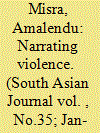

|
|
|
| 13 |
ID:
167279
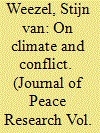

|
|
|
|
|
| Summary/Abstract |
This study exploits a sudden and abrupt decline in precipitation of the long rains season in the Horn of Africa to analyze the possible link between climate change and violent armed conflict. Following the 1998 El Niño there has been an overall reduction in precipitation levels – associated with sea-surface temperature changes in the Indian and Pacific Oceans – resulting in an increase in the number and severity of droughts. Given that the probable cause of this shift is anthropogenic forcing, it provides a unique opportunity to study the effect of climate change on society compared to statistical inference based on weather variation. Focusing on communal conflict in Ethiopia and Kenya between 1999 and 2014, exploiting cross-sectional variation across districts, the regression analysis links the precipitation decline to an additional 1.3 conflict events per district. The main estimates show that there is a negative correlation between precipitation and communal conflict with a probability of 0.90. Changing model specification to consider plausible alternative models and accommodate other identifying assumptions produces broadly similar results. The generaliziability of the link between precipitation decline and conflict breaks down when using out-of-sample cross-validation to test the external validity. A leave-one-out cross-validation exercise shows that accounting for climate contributes relatively little to improving the predictive performance of the model. This suggests that there are other more salient factors underlying communal violence in Ethiopia and Kenya. As such, in this case the link between climate and conflict should not be overstated.
|
|
|
|
|
|
|
|
|
|
|
|
|
|
|
|
| 14 |
ID:
142045
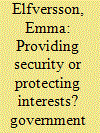

|
|
|
|
|
| Summary/Abstract |
What factors drive governments’ decisions to intervene in local conflicts within their borders? Communal conflict – that is, organized violence between non-state groups that are mobilized along a shared communal identity – kills thousands each year and severely impacts local livelihoods, at times threatening to spread and affect entire regions. Given the state’s assumed monopoly over the legitimate use of force, we should expect the concerned governments to be critical actors of the overall effort to restore peace in cases of local communal conflict, but empirical evidence indicates that central states tend to only intervene in some cases but not in others. This phenomenon has so far been understudied and the variations in states’ efforts to manage these conflicts remain unexplained. This article presents the first quantitative study of state intervention in communal conflicts. Building on existing scholarly work, I argue that state intervention is explained by a combination of strategic interests and state capacity, and that interests related to ethnic constituencies and land control play an important part in explaining governments’ strategies. These propositions find support in a statistical analysis covering sub-Saharan Africa from 1989 to 2010.
|
|
|
|
|
|
|
|
|
|
|
|
|
|
|
|
| 15 |
ID:
185242
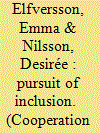

|
|
|
|
|
| Summary/Abstract |
Why are some peace processes in communal conflicts more inclusive of civil society actors than others? Inclusion of civil society actors, such as churches and religious leaders, women’s organizations, or youth groups, is seen as important for normative reasons, and studies also suggest that civil society inclusion can improve the prospects for durable peace. Yet, we have a very limited understanding of why we observe inclusion in some communal conflicts but not others. We address this gap by theorizing about various forms of civil society inclusion in local peace processes, and examining to what extent involvement by different types of third-party actors—governments, inter-governmental organizations (IGOs), and non-governmental organizations (NGOs)—may contribute to inclusion. Empirically, we draw on a combination of cross-case and in-depth data covering peace negotiations in communal conflicts in Kenya. The findings show that civil society was less frequently included as facilitators when the government was involved as a third party, while inclusion in the form of direct participation of civil society in negotiations, or via involvement in the implementation phase, was equally common across different types of third-party actors. Our study thus provides important new insights regarding how inclusion plays out in communal conflicts.
|
|
|
|
|
|
|
|
|
|
|
|
|
|
|
|
| 16 |
ID:
170813
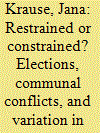

|
|
|
|
|
| Summary/Abstract |
Anecdotal evidence suggests that sexual violence varies significantly across cases of election violence and communal conflicts but systematic research is scarce. Post-election violence is particularly likely if electoral mobilization further polarizes longstanding communal conflicts and political elites do not instruct security forces to intervene decisively. I comparatively analyse two prominent cases of post-election violence in Kenya (2007/8) and Nigeria (2008) that exhibit stark variation in sexual violence. Patrimonial networks and norms of violent masculinity that increase the probability of (gang) rape were present in both cases and do not explain variation. Civil war research has identified three explanations for the variation in sexual violence: situational constraints; ordered sexual violence or restraint; and bottom-up dynamics of sexual violence or restraint. I examine these for the context of post-election violence. I argue that the type of communal conflict triggered by electoral mobilization explains variation in sexual violence. In Kenya, pogroms of a majority group against a minority allowed for the time and space to perpetrate widespread sexual violence while in Nigeria, dyadic clashes between similarly strong groups offered less opportunity but produced a significantly higher death toll. These findings have important implications for preventing election violence. They demonstrate that civilian vulnerability is gendered and that high levels of sexual violence do not necessarily correspond to high levels of lethal violence. Ignoring sexual violence means underestimating the real intensity of conflict and its impact on the political process.
|
|
|
|
|
|
|
|
|
|
|
|
|
|
|
|
| 17 |
ID:
175390
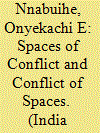

|
|
|
|
|
| Summary/Abstract |
Communal violence, one of the deadliest forms of political violence in Africa, has characterised Jos and other central Nigerian cities since the 1990s. With origins in colonial land and administrative policies at the inception of the city, communal tensions rooted in local elite competition over ‘indigeneship’ and entitlement to political and government positions, access to higher education and land rights have manifested more forcefully in contemporary time claiming over 5,000 lives. This article focuses on the relationship between collective identity, struggle for space and collective violence. It explores persistent attachment to territory by urban communal groups and violent conflicts over those territorial stakes. It does so because emerging research has focused on land rights, neglecting how conflicts structure territory—the living space—and how territory, in turn, shapes conflict. Inspired by the motivation versus opportunity framework, it relies on focus groups, interviews, oral history, archival documents and secondary sources to generate data.
|
|
|
|
|
|
|
|
|
|
|
|
|
|
|
|
| 18 |
ID:
181087
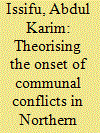

|
|
|
|
|
| Summary/Abstract |
Communal conflicts present a severe threat to human security, resulting in the death of thousands of people every year. The communal conflict in Dagbon in the Northern Region of Ghana, for instance, led to the murder of the King of Dagbon and 40 other people. This conflict has attracted debates which are centred around attempts to explain its onset. But the understanding of this phenomenon is still incomplete. In particular, there is inadequate detailed information about what actually started the conflict. This article aims to fill this knowledge gap by engaging the greed-grievance theories to comprehensively understand the conflict’s onset. This article contributes to the theoretical understanding of communal conflicts, which is of both scholarly and policy importance. Navigating insights from theoretical literature and content analysis of secondary data, it finds that perceived injustice and land wealth were the motivating factors in the onset of the conflict in Dagbon in 2002.
|
|
|
|
|
|
|
|
|
|
|
|
|
|
|
|
| 19 |
ID:
160530
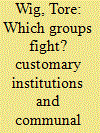

|
|
|
|
|
| Summary/Abstract |
Why are some ethnic groups embroiled in communal conflicts while others are comparably peaceful? We explore the group-specific correlates of communal conflicts in Africa by utilizing a novel dataset combining ethnographic information on group characteristics with conflict data. Specifically, we investigate whether features of the customary political institutions of ethnic groups matter for their communal-conflict involvement. We show how institutional explanations for conflict, developed to explain state-based wars, can be successfully applied to the customary institutions of ethnic groups. We argue that customary institutions can pacify through facilitating credible nonviolent bargaining. Studying 143 ethnic groups, we provide large-N evidence for such an ‘ethnic civil peace’, showing that groups with a higher number of formalized customary institutions, like houses of chiefs, courts and legislatures, are less prone to communal conflict, both internally and with other groups. We also find some evidence, although slightly weaker, that groups with more inclusive or ‘democratic’ customary institutions are less prone to communal conflicts.
|
|
|
|
|
|
|
|
|
|
|
|
|
|
|
|
|
|
|
|
|